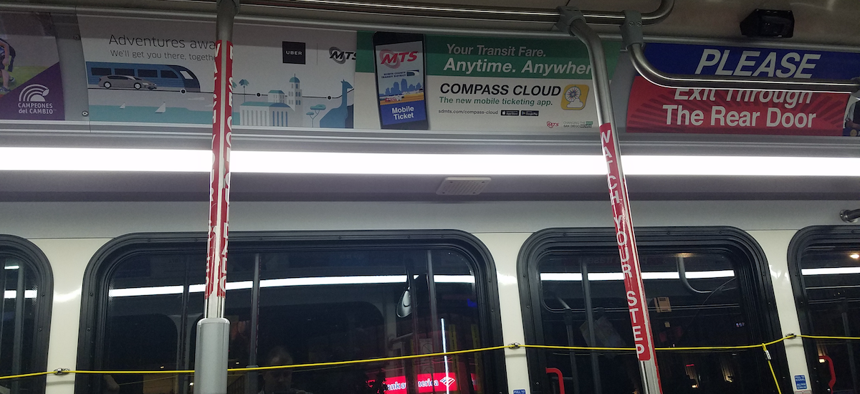When Seconds Matter, Tiny Flaws in User Design Can Slow Things Down

The MTS 922 bus connects downtown San Diego and the airport. Michael Grass / Route Fifty
Bus service can be delayed for a variety of reasons, including squinting. Yes, squinting.
SAN DIEGO — The Metropolitan Transit System’s No. 922 bus can be a handy way of going to and from the downtown area of California’s second-largest city and the airport. The 922 has a direct route through the middle of the central business district on Broadway and along San Diego’s scenic bayfront.

MTS, which manages local, express and rapid bus services and San Diego’s Trolley light-rail system has a Regional Daypass, valid for unlimited rides across its network and the commuter rail lines operated by the North County Transit District.
If you have a Compass Card, the San Diego area's electronic transit farecard, the pass is only $5. If you’re paying onboard with cash, it’s $7—still a good deal if you’re planning to take a couple transit trips over the course of a day. Simply tell the driver you want the $7 all-day pass, insert a $5 bill and two $1 bills into the fare box, and voila, the pass pops out of the top of the farebox machine and you’re good to go.
That’s what I did earlier this week during an extra-long layover in San Diego. I rode the 922 bus into downtown from the airport, explored the central business district, the Gaslamp Quarter, rode the Trolley’s Green Line, ate some fish tacos and wrote an article about San Diego’s deadly ongoing hepatitis A outbreak.
An all-day transit pass should be something that can be flashed at the driver fairly quickly when boarding. But there’s a small flaw in the design of the MTS Regional Daypass: The expiration time printed on the back of the ticket might be too small for some bus drivers to quickly scan to confirm that the user isn’t using an expired pass.

On my return trip to the airport from downtown, I boarded the 922 bus on Broadway near the historic Santa Fe Depot, and showed the driver my Regional Daypass. He took the ticket from my hand, flipped it over, pulled it closer to his face, squinted his eyes to look for the expiration.
The experience reminded me of riding a Metrobus in Washington, D.C. before the elimination of paper transfers, where drivers had to check to see where the transfer—which displayed hours of the day in strip form—had been ripped by the previous driver in order to determine whether the transfer was still valid.
Sure, that visual inspection process takes a few seconds longer than it probably should. And you might be saying to yourself: So what? It’s a few extra seconds.
While that’s true, it’s important to remember that those seconds can add up along the length of a bus route and can trigger additional delays.
Here’s what happened to me: Just as the driver of the 922 bus began to pull away from the curb to continue along its airport-bound route on Broadway, a traffic signal at Columbia Street went from green to yellow to red. The bus stopped. Then there was another red light at India Street.
And then, as the bus approached a railroad crossing for the MTS Trolley’s Green Line, a light-rail train approached, lights began to flash and the gates came down. I wasn’t timing how long it took for the train to clear the crossing, but during the wait, I was thinking about how if the Regional Daypass expiration date and time were larger and had an easier-to-read typeface, the driver would have been able to inspect it faster and not hit the series of red traffic signals. Then it wouldn’t have been stopped by the train at the crossing.
While the circumstances and location might differ, any regular bus commuter can likely identify with that situation in downtown San Diego.
That’s why transit agencies across the nation have tried to figure out ways to speed up the bus-boarding process. Some have embraced off-board payment methods, allowed all-door entry, promoted the use of electronic farecards and eliminated paper transfers.
I contrast my experience in San Diego with a recent trip to San Antonio, where I used a mobile ticketing app on my smartphone to purchase an all-day $2.75 transit pass. All I had to do was get the digital pass ready on my phone, quickly flash the pass at the driver and take a seat. The typeface for the digital pass expiration was large and easy to read. The bus drivers I encountered in San Antonio didn’t have to pause and squint.
MTS in San Diego has a new mobile ticketing app, but I didn’t use it since I had the printed pass. If I’d gone with the mobile ticketing app, I might have been able to speed up my trip—and the trip of other bus riders on the 922—to the airport.
Michael Grass is Executive Editor of Government Executive’s Route Fifty and is based in Seattle.
NEXT STORY: Coming This Week: Navigator Award 2017 Winners






